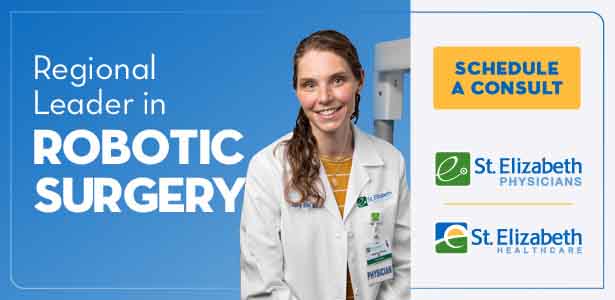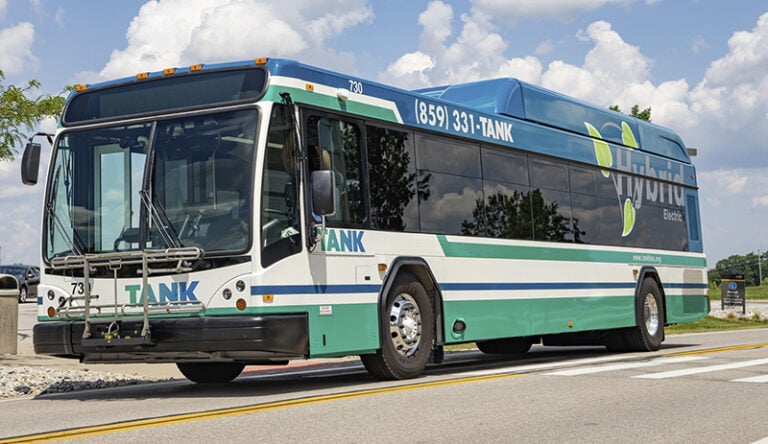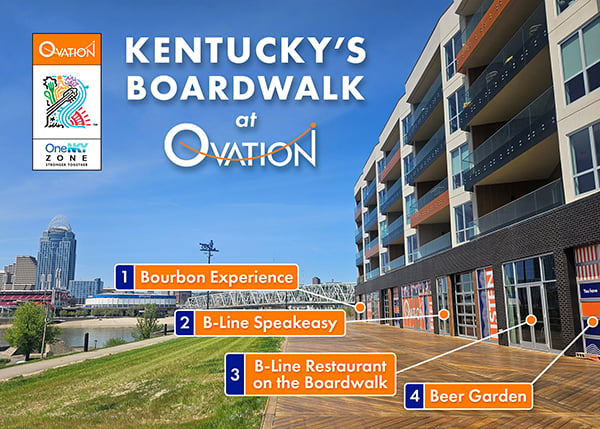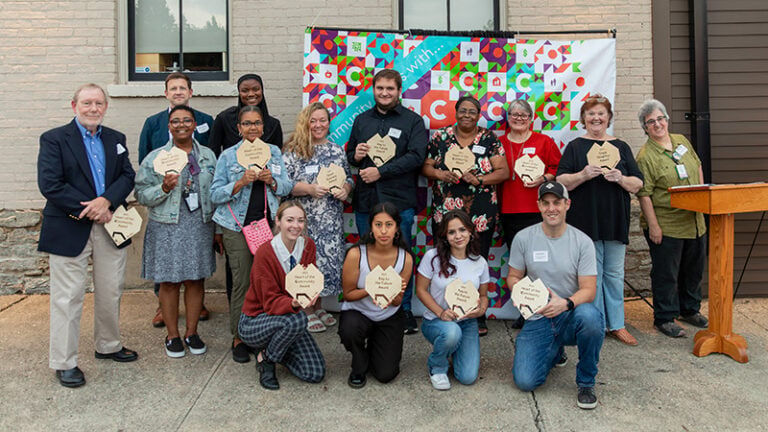By Greg Paeth
NKy Tribune senior reporter
As Kris Kimel recalls the genesis of the space satellite program in Kentucky, he had flown to Mountain View, California, in January of 2006 to get an update on a project that Lexington’s Kentucky Space was doing for NASA, whose sprawling Ames Research Center dates to 1939, some 30 years before anyone would label that part of California “Silicon Valley.”
Kentucky Space, a non-profit owned by another Lexington-based non-profit, the Kentucky Science and Technology Corp. (KSTC), had been working on technology that could be used to explore beneath the surface of the moon or distant planets.
To a small degree, the project was the result of the relationship between Kimel and G. Scott Hubbard, who’s from Elizabethtown and was then the director of the Ames Research Center, one of 10 such facilities in the country for the National Aeronautics and Space Administration. The Kentuckians had met some years earlier at Ames.
KSTC had established a small office inside Ames in 2004 with a straightforward objective.

“The main thing is we wanted to create a presence out there and a presence in the middle of Silicon Valley,” said Kimel, president of the KSTC, which he co-founded in 1987 with former UK president Lee Todd. “We had no idea of what the outcome of that office might be, but we knew there were a lot of creative, smart people out there and we wanted to be in the middle of them.”
While he was in California in 2006, Kimel had lunch with Greg Schmidt, who worked for Hubbard at Ames. Kimel recalls a general discussion about what kind of role Kentucky Space might play in developing technology used in space exploration. At one point during the conversation, Schmidt suggested that Kimel should sit down with Bob Twiggs, one of those “creative, smart people” that the Kentucky Space office had been designed to attract.
“Greg Schmidt said, ‘Something remarkable might happen and let’s just see.’ That was very much the philosophy of it (meeting with Twiggs),” Kimel said.
At the time, Twiggs was a consulting professor and founder of the Space Systems Development Lab at nearby Stanford University, one of the country’s most prestigious universities, a world leader in technology and the alma mater of many of the “creative, smart people” who have made Silicon Valley synonymous with stunning technological breakthroughs and the astronomical wealth that technology can create.
Schmidt called Twiggs and the three men agreed to sit down and chat, a conversation Kimel now describes as “serendipitous.”
Twiggs recalls that he brought a model of a “CubeSat” to one of the classrooms at what had been the enlisted men’s recreation center for Moffett Field, a former naval air station that is now part of the Ames Research Center. Much of the conversation focused on the cubical satellites that an adult can hold in the palm of his or her hand. They measure 10 x 10 x 10 centimeters (roughly 4 inches per side) and ride inside of another spacecraft until they are released into orbit.
Making small spacecraft
Twiggs is co-inventor of the CubeSat technology and has spent roughly 20 years designing compact “nanosatellites” that can now be built because of the miniaturization of technology (think smart phones) and relatively inexpensive launch costs for small, light-weight spacecraft.
As the meeting progressed, it became clear to Kimel that Twiggs believed Kentucky Space could partner with Stanford on CubeSat research and production.
When he returned to Kentucky, Kimel called Benjamin Malphrus, who was then deeply immersed in two major projects at Morehead State University.
“I asked Ben, ‘What do you think about partnering with Stanford to build small spacecraft?’ Ben thought about it for about two seconds and said, ‘Yeah, let’s do it’,” Kimel said.

At that time Malphrus, who chairs the Department of Earth and Space Sciences and is the director of the Space Science Center at Morehead, was completing work on the university’s 21-meter space tracking antenna and radio telescope, which is one of about a dozen large dishes in the country. He also was playing a leading role in the design of Morehead’s $16 million Space Science Center, which opened in 2009 and established Morehead as one of five U.S. universities that offer a degree in space science.
The tracking antenna and telescope allow students and faculty at Morehead to control the satellites and collect data that they transmit.
Today, research at Morehead, the University of Kentucky, the University of Louisville and Western Kentucky University along with Kentucky Space, a for-profit company called Space Tango and several other enterprises are beginning to nudge Kentucky’s economy beyond the unflattering perception that the state’s expertise extends no further than coal, tobacco, bourbon, racehorses and college basketball.
‘Entrepreneurial space’
“What we’re doing is building a new industry in Kentucky around entrepreneurial space — not aerospace — it’s entrepreneurial space,” said Kimel, who emphasized that he believes small satellite development is important for two reasons.
The first involves developing satellites that can be used by other entrepreneurs and scientists who want to do research in space, in effect allowing them to buy a ticket on a Kentucky satellite that would be launched into space by a third party.
“In seven months we’re putting a new lab on the International Space Station that will give us the ability to fly experiments into microgravity,” said Kimel.
The mission to the space station is possible because Kentucky Space recently completed a five-year agreement with the space station, a joint project of the U.S., Europe, Canada, Japan and Russia.
“It’s going to provide a pathway for a lot of emerging companies in a variety of fields, including students and others…to do things here (in Kentucky) that you can’t do anywhere else,” Kimel said. About 60 percent of the available space on what’s being called “TangoLab-1” has been “pre-sold” for a launch next summer.
A second lab that will journey to the space station will be devoted solely to “exomedicine” – medical research in the “microgravity environment” of space.
“It’s a new frontier. We don’t know (for example) how cancer cells operate outside of gravity. The conditions are there for some game-changing things to occur,” Kimel said.
Exomedicine and more
In addition to access for other scientists to conduct experiments in space, Kimil said Kentucky Space and its related companies will retain some of the lab’s capacity for their own research. The Exomedicine Institute, based in Lexington, is another in a myriad of interlocking high-tech space enterprises in which Kimel plays a major role.
The ability to launch spacecraft had been something reserved only for governments. But that has changed in recent years, making it possible for Kentucky Space to put satellites in orbit and, in effect, rent lab space on the space station.
In its summary of activity for last year at the Kennedy Space Center, where Kentucky Space has a second office, NASA emphasized its changing role. The space agency said in a news release that the space center “…accomplished many milestones in 2013 as it continued to transition from a historically government-only launch facility to an affordable, sustainable, multiuser spaceport for both government and commercial customers.”
Last fall, when the state hosted writers from around the country for a “Startup in Kentucky” media tour, the journalists spent half a day touring the Space Science Center at Morehead, where they talked with Malphrus and Twiggs, who migrated to Kentucky to become a professor of space science in 2009. Behind glass in the foyer of the space center, in a display case where one might expect to find a trophy from a basketball tournament, circa 1978, is the first CubeSat that was built by Twiggs and his colleagues.
A new economy
The emphasis for the entire tour, a prelude to the annual IdeaFestival in Louisville, was high-tech enterprises in Louisville, Lexington, Covington, Morehead and a dozen other cities that were represented at Startup events.
During the Morehead presentation, state officials emphasized that the aerospace industry – including the spacecraft research and production at the universities – are now the single largest export category for the state, which set consecutive export records in each of the last three years and is on pace to establish another record this year.
Aerospace accounted for $5.6 billion of Kentucky’s $25.3 billion in exports last year, when total exports grew by 14 percent over 2012. For the first time, aerospace edged ahead of the manufacturing of motor vehicles and parts that are sold in foreign markets, according to the Kentucky Cabinet for Economic Development.

With major manufacturing facilities for Toyota in Georgetown, two Ford plants in Louisville and GM production in Bowling Green, products “Made in Kentucky” are as obvious as the Camry parked at Walmart or the Corvette idling at a traffic light in Owensboro. There aren’t many mysteries in the automotive category.
But that’s not the case for Kentucky’s aerospace industry, which grew by a stunning 47 percent from 2012 to 2013 and is on pace to set another record this year. The state, however, could provide few details about the components of the aerospace category.
State export figures reflect data gathered by the federal government’s Bureau of Labor Statistics, which doesn’t provide any breakdown of the overall total, according to Joe Hall, a spokesman for the Cabinet for Economic Development.
Hall did release a report about 51 companies that the state labels as “aerospace facilities.” Companies listed in the report ranged from well-known aviation manufacturers such as GE Aircraft Engines in Madisonville and Lockheed Martin in Lexington to package delivery companies DHL and UPS and Catlettsburg Refining, a subsidiary of Marathon Oil.
Malphrus said he believes much of the $5.6 billion figure can be traced directly to the presence of major manufacturers like GE, whose jet engines are used to power some of the aircraft manufactured by Airbus, the European consortium headquartered in Toulouse, France. He mentioned Lockheed Martin, Belcan and Highlands Diversified Services as some of the other major contributors to the aerospace category.
Currently, satellite design and production in Kentucky is just a tiny fraction of aerospace exports, a little more than $175,000 last year, according to figures released by the state. Kimel, who sounds eternally optimistic about Kentucky’s high-tech future, is not discouraged by the fact that research, development and production of spacecraft have not yet produced splashy numbers for the Kentucky economy.
“It’s a small piece economically (of the $5.6 billion in exports), but I don’t know that it’s a small piece in terms of knowledge generation,” Kimel said.
Tracking expenditures on spacecraft design and fabrication appears to be an inexact science. Malphrus said Kentucky Space and Morehead invested about $1 million in the Cosmic X-Ray Background NanoSatellite, which was designed and built solely by students and faculty at Morehead. CXBN, comprised of two CubeSats, was launched in 2012 and became the first Kentucky-produced satellite to fly successfully.
PocketQubs
Kimel was equally enthusiastic about advances with two of Twiggs’ “PocketQubs,” which are smaller than the CubeSats, and were launched from Yasny, Russia, in November of 2013.

“To our knowledge, they are the smallest satellites ever put into orbit successfully,” said Kimel. “The economic benefit at this point may be a slice of that, but I would argue that knowledge development and the potential outstrips a lot of the financially successful efforts at this point…If we’re successful, the financial piece of that for Kentucky could be substantial.”
Two days before the launch in Russia, KySat-2 – a CubeSat put together by Kentucky Space along with students and faculty from UK and Morehead – was launched at the NASA facility at Wallops Island, VA. A couple of the components of KySat-2 were made by UK engineering students on a 3-D printer. One of the missions for the satellite was to develop technology that would provide more precise measurements of the Earth’s magnetic field.
KySat-2’s predecessor, the appropriately named KySat-1, was a huge disappointment for Kentucky Space and everyone else involved with the project. The satellite was aboard NASA’s Glory spacecraft, which lifted off on March 4, 2011 and flew for just minutes before it plunged into the Pacific after a protective nosecone shield didn’t open completely. Kimel said KySat-1 was valued at about $150,000, a minute fraction of the estimated $450 million that NASA invested in Glory.
Kimel, whose KSTC is a $17 million-a-year non-profit, is well aware that building a new economic model can be a gamble.
“Quite frankly, from Kentucky’s standpoint, not only can we do this, but we have to do things like this. We have to be willing to venture out into areas that are high-risk, high-return,” Kimel said. “Certainly we can fail, but we need a new trajectory. The way that you really progress and the way you are successful today is to do something remarkable, something other people haven’t done a lot of. In this entrepreneurial space area, we are early leaders in this thing…We are pursuing some very, very novel research. We don’t know where it’s going to take us, but we feel confident and we want to be a global leader in the technology.”
Malphrus, whose accomplishments include research that led to the discovery of a new galaxy, demonstrated a scientist’s reluctance to overstate expectations.
A bigger vision
From day one of the satellite work in Kentucky, Malphrus said everyone involved envisioned “a cottage industry” that wouldn’t surpass the state’s multi-billion-dollar production of components for airplanes and helicopters.
“Kris’ vision that we all shared was to evolve the space segment of aerospace in Kentucky coincident with the aero side. I think the vision is coming true,” Malphrus said. “It’ll certainly be a piece (of the aerospace segment). It may not be a major piece of the overall economy, but it’ll be an important piece. For example, the use of nanosatellites is exploding.”
A recent study by SpaceWorks Enterprises, a well-respected aerospace firm based in Atlanta, projects that the number of small satellites that will be launched in the next six years will grow by about 24 percent annually until 2020, when the company predicts that somewhere between 410 and 543 will be launched. By comparison, 92 small satellites were launched last year.
“Economy’s evolve. Our economy was based on agriculture and extractive industries in the 70s and 80s, and then it moved into automotive and now it’s high-tech — aerospace and automotive,” said Malphrus. “It’s a natural evolution from agrarian to extractive industries to industrial to high-tech.”

Bob Twiggs, who retired from Stanford in 2008 and took a year off to return with his wife to their home state of Idaho, said he joined the Morehead faculty in 2009 with the intention of working for two years, a plan that obviously fell by the wayside.
The hardware at Morehead as well as the atmosphere were factors in Twiggs’ decision to end his retirement.
“I had been to the Morehead campus a couple of times and I knew Ben (Malphrus) had this big antenna out here and when you’re a space guy, that’s pretty attractive,” Twiggs said. “Everybody here is very, very supportive of the program and at Stanford we were just small fish in a big pond.”
Twiggs said a couple of those small fish – Stanford students he had taught – did quite well with Skybox Imaging, a five-year-old company that uses CubeSat technology to take high resolution photos of the earth twice a day. Last Aug. 1, Skybox announced that it was being acquired by Google for $500 million.
“One of the things I’m very interested in is to try and do things with what we put on the space station and satellites to do microgravity research because I think that’s going to be a big thing. Kris Kimel is pushing that – what he calls exomedicine,” Twiggs said. “I’ve been around small satellites long enough that I’m kind of blasé about that…I know I can build small satellites and fly them.That’s cool. But if we can do something with microgravity research, I think some significant things can come out of that.”
Twiggs said Morehead is much better known outside of Kentucky in the space area and that the school is now collaborating on projects with two of the country’s premier research institutions, MIT and the Jet Propulsion Laboratory, the NASA research facility that is managed by Caltech.
“We had eight guys from Pasadena (where the Jet Propulsion Lab is located) visiting recently,” Twiggs said. “We’re out here in little old Space Hollow and when you have people from the Jet Propulsion Lab come to visit you, that’s a pretty good compliment.”
This story was a project of the Kentucky Center for Public Service Journalism, publisher of the NKy Tribune. Greg Paeth is a senior reporter for The Center.



















Who knew? What a feather in the commonwealth’s cap and what a great read. Thanks Greg – great to see your writing again.